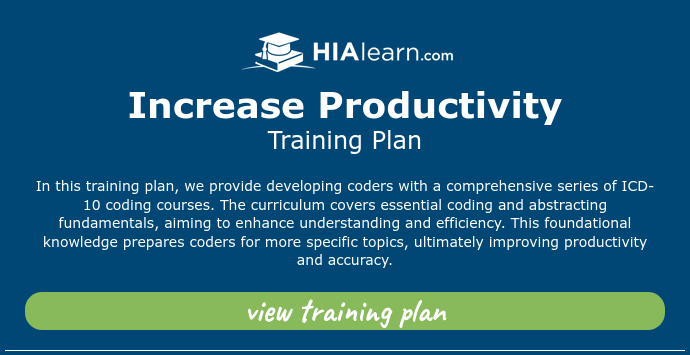
Whether you’re supporting inpatient, outpatient, or professional fee services, finding the right balance ensures cleaner claims, fewer denials, and a smoother audit trail. Below are practical, actionable tips to help you streamline your coding without compromising quality.
Why Speed and Accuracy Must Work Together
High productivity means nothing if accuracy suffers—and perfect accuracy means little if claims stall in a backlog. Coding teams that balance both see benefits such as:
- Stronger compliance and audit outcomes
- Enhanced team reliability and trust
- Improved revenue cycle performance
- More consistent daily workloads
Rather than thinking of “speed vs. accuracy,” coders should aim for intentional efficiency—coding smarter, not faster.
Productivity Tips for Medical Coders
1. Start With the Documentation—Not the Codes
Jumping straight into code sets often leads to missed details and sequencing errors. Before coding:
- Scan for the reason for the encounter or principal diagnosis
- Identify key supporting conditions
- Confirm procedures, timing, and specificity
- Check for any missing elements that may require a query
A strong first review reduces rework on the back end.
2. Use Coding Guidelines as Your Shortcut, Not Your Slowdown
Many coders fear guidelines will slow them down—but the opposite is true. Guidelines reduce guesswork and prevent time-consuming corrections later. Make it a habit to:
- Revisit specialty-specific guidelines weekly
- Keep CMS, CPT, and ICD-10 references open in tabs or dual monitors
- Bookmark tricky guidelines you encounter often
Updating your guideline knowledge is the most efficient way to maintain accuracy at high volume.
3. Build a Personal Quick-Reference Library
Every coder has recurring case types. Instead of looking up the same information repeatedly, create a personalized system:
- A folder of bookmarked official guideline pages
- A document with commonly assigned codes
- Quick-check reminders for your specialty (e.g., fractures, ECGs, infusion hierarchy, obstetrics sequencing)
This reduces mental load and helps you maintain consistency over time.
4. Master Your EHR and Encoder Shortcuts
You can save hours each week by using the tools already in front of you. Consider exploring:
- Auto-routing features
- Favorite or frequently used code lists
- Keyboard shortcuts
- Templates built into your EHR Batch-handling functions
- The ability to split screens or hover for details
Your encoder is also rich with timesavers—practice searching by synonyms, abbreviations, and key terms for faster navigation.
5. Create a Repeatable Workflow System
Coders who follow the same sequence every time build both accuracy and speed. A sample workflow might be:
- Documentation review
- Identify principal diagnosis or primary reason for visit
- Capture secondary diagnoses
- Assign procedures
- Double-check sequencing
- Run edits or scrubber rules
- Final accuracy check
A consistent process leaves less room for error and reduces cognitive load.
6. Use the “Three-Pass Rule”
A simple structure that prevents overthinking:
- Pass One: Assign obvious diagnoses and procedures
- Pass Two: Verify guidelines and sequencing
- Pass Three: Run edits and review alerts
This maintains momentum while keeping accuracy checks built into the process.
7. Reduce Disruptions by Using Focus Blocks
Multitasking is one of the fastest ways to lose accuracy. Try working in twenty-five to forty-five–minute focus blocks followed by short breaks. During focus time:
- Silence notifications
- Close extra browser tabs
- Allow your queue to refresh only when the block ends
Your accuracy rate will improve purely from fewer mental resets.
8. Track Your Own Data
High-performing coders treat productivity and accuracy as measurable skills. Keep a personal record of:
- Cases per hour or per shift
- Error trends
- Types of cases that come back for rework
- Productivity dips and what caused them
This helps you identify patterns—like which case types slow you down, or which guidelines you need to revisit.
9. Use Audit Results as Learning Tools, Not Frustrations
Audits slow productivity, but they also provide the greatest insight into improvement. Each time you receive one:
- Add the results to your quick-reference
- Revisit related guidelines
- Ask your coding lead or auditor for clarification
The more completely you incorporate results, the faster you naturally become.
10. Set Daily Micro-Goals
Instead of targeting large volume metrics all at once, break them down:
- “Code fifteen accounts before lunch.”
- “Finish all E&M visits before two o’clock.”
- “Review ten discharged not final coded cases by end of day.”
Small goals create forward momentum and reduce end-of-day stress.
The Bottom Line
Speed and accuracy are not competing priorities—they are complementary skills strengthened through consistent practice, thoughtful workflows, and ongoing education. Coders who adopt smart productivity habits experience:
- Higher accuracy rates
- Faster claim submission
- Stronger confidence in complex cases
- Fewer distractions and fewer revisions
With continued learning and discipline, you can build a workflow that supports both precision and productivity every day.
Frequently Asked Questions
Q: How can medical coders improve productivity without sacrificing accuracy?
Q: What are the most effective habits for maintaining accuracy in high-volume coding?
Q: How can coders reduce distractions and stay focused during their shifts?
HIAlearn, powered by Health Information Associates (HIA)—a leader in medical coding and auditing for more than three decades—offers a flexible, online education platform designed for today’s coders. With a growing catalog of AHIMA and AAPC-approved coding courses, HIAlearn supports both beginners and experienced coders looking to build confidence, accuracy, and CEU credits.
Courses are available across various coding types including CPT, E/M, ICD-10-CM, and ICD-10-PCS, and are designed for multiple specialties including inpatient, outpatient, profee, and CDI.
To stay up to date, coders can explore our Coding Updates hub for the latest ICD-10-CM, ICD-10-PCS, CPT, and IPPS changes. HIAlearn also supports organizations with group discounts and scalable team access, promoting accuracy, compliance, and continuous professional development across departments.
The information contained in this blog post is valid at the time of posting. Viewers are encouraged to research subsequent official guidance in the areas associated with the topic as they can change rapidly.





